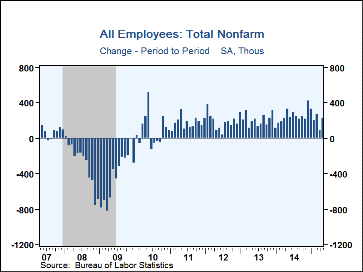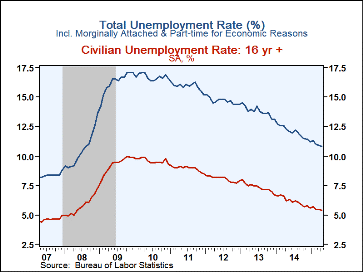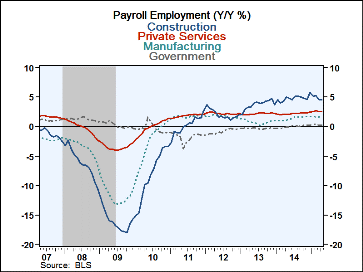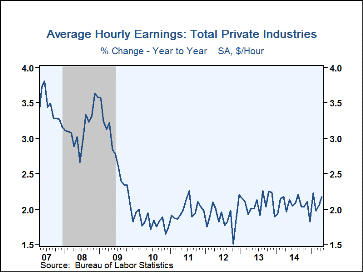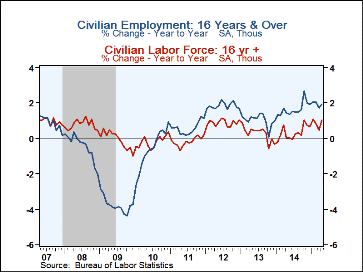 Global| May 08 2015
Global| May 08 2015U.S. Payroll Employment Improves; Jobless Rate Declines to 2008 Low
by:Tom Moeller
|in:Economy in Brief
Summary
Nonfarm payroll employment during April increased 223,000 (2.2% y/y) following an 85,000 March rise, revised from 126,000. Expectations roughly matched a 225,000 gain in the Action Economics Forecast Survey. Improvement in services [...]
Nonfarm payroll employment during April increased 223,000 (2.2% y/y) following an 85,000 March rise, revised from 126,000. Expectations roughly matched a 225,000 gain in the Action Economics Forecast Survey. Improvement in services and construction employment led last month's increase. The unemployment rate moved in line with expectations, falling to 5.4%, the lowest level since May 2008. The overall unemployment rate, including marginally attached and those working part-time for economic reasons, slipped to a new low of 10.8%. Average hourly earnings ticked 0.1% higher (2.2% y/y), disappointing expectations for a 0.2% rise.
From the payroll employment survey, the 223,000 job increase last month left the three-month rise at 191,000. That compares to roughly 250,000 gains one year ago. Growth in factory sector payrolls came to a standstill in April, up just 1,000 (1.5% y/y) following no change. Mining & logging employment fell 15,000 (-2.4% y/y), the largest of the declines during each of the last four months. Construction sector job creation offset some of these disappointments with a 45,000 increase (4.6% y/y), rebounding after a 9,000 decline.
The private service sector job increase improved to 182,000 (2.5% y/y) after a depressed 115,000 rise. Professional & business services jobs gained 62,000 (3.5% y/y), this year's firmest increase. Within that increase, temporary help gained a modest 16,100 (5.5% y/y). Health care & social assistance employment rose 55,600 (2.8% y/y), the strongest rise since November. Jobs in trade, transportation & utilities advanced 24,000 (2.1% y/y), the weakest gain since December. Leisure & hospitality employment improved 17,000 (3.0% y/y) while transportation & warehousing employment gained 15,200 (3.6% y/y). Retail trade jobs grew 12,100 (1.9% y/y), the weakest rise this year, and jobs in education improved 5,200 (1.7% y/y). Financial sector jobs rose 9,000 (1.9% y/y) while information services employment advanced 3,000 (2.0% y/y). Government sector employment rose 10,000, the strongest gain since December. Federal sector jobs grew 2,000 (0.2% y/y), state government hiring grew 1,000 (0.5% y/y) and local government employment advanced 7,000 (0.2% y/y).
The length of the average workweek remained unchanged at 34.5 hours, though that was down from 34.6 averaged from October to February. Mining & logging hours, which have been declining steadily for the last six months, fell to 44.3. Factory sector hours slipped to 40.8 and construction hours fell to 38.9 hours. Service sector hours fell to 33.3, the weakest since September.
Average hourly earnings ticked just 0.1% higher (2.2% y/y). Factory sector earnings grew 0.1% (1.8% y/y). Service producing earnings also improved 0.1% (2.2% y/y).
The household sector numbers showed the unemployment rate declining to 5.4%. Employment increased 192,000 (1.9% y/y), the strongest gain in three months. The labor force rose 166,000 (1.1% y/y) as the labor force participation rate improved minimally to 62.8%. Nevertheless, it's been near there for the last twelve months and remained down from 67.1% averaged from 1997 to 2000. The current 62.8% rate hasn't been this low since 1978. The number of potential workers not in the labor force grew 1.3% y/y, though that gain slowed from 2.9% during all of 2010. The average duration of unemployment fell to 30.8 weeks from its 2011 high of 40.6 weeks.
Unemployment amongst adult men and women was roughly equal near 5.0%. For teenagers, it averaged 17.1%, 27.5% for black teens and 14.5% for whites.
The unemployment rate for those without a high school diploma averaged 8.6% while high school graduates were 5.4% unemployed. Individuals with some college saw 4.7% unemployment and 2.7% of college graduates were out of work.
The labor market data is contained Haver's USECON database. Detailed figures are in the EMPL and LABOR databases. The expectations figure is in the AS1REPNA database.
| Employment: (M/M Chg., 000s) | Apr | Mar | Feb | Y/Y | 2014 | 2013 | 2012 |
|---|---|---|---|---|---|---|---|
| Payroll Employment | 223 | 85 | 266 | 2.2% | 1.9% | 1.7% | 1.7% |
| Previous | -- | 126 | 264 | -- | -- | -- | -- |
| Manufacturing | 1 | 0 | 3 | 1.5 | 1.4 | 0.8 | 1.7 |
| Construction | 45 | -9 | 31 | 4.6 | 4.8 | 3.7 | 2.1 |
| Private Service Producing | 182 | 115 | 241 | 2.5 | 2.2 | 2.2 | 2.2 |
| Government | 10 | -9 | 5 | 0.3 | 0.0 | -0.3 | -0.8 |
| Average Weekly Hours - Private Sector | 34.5 | 34.5 | 34.6 | 34.5 (Apr.'14) |
34.5 | 34.5 | 34.4 |
| Private Sector Average Hourly Earnings (%) | 0.1 | 0.2 | 0.1 | 2.2 | 2.1 | 2.1 | 1.9 |
| Unemployment Rate (%) | 5.4 | 5.5 | 5.5 | 6.2 (Apr.'14) |
6.1 | 7.4 | 8.1 |
Tom Moeller
AuthorMore in Author Profile »Prior to joining Haver Analytics in 2000, Mr. Moeller worked as the Economist at Chancellor Capital Management from 1985 to 1999. There, he developed comprehensive economic forecasts and interpreted economic data for equity and fixed income portfolio managers. Also at Chancellor, Mr. Moeller worked as an equity analyst and was responsible for researching and rating companies in the economically sensitive automobile and housing industries for investment in Chancellor’s equity portfolio. Prior to joining Chancellor, Mr. Moeller was an Economist at Citibank from 1979 to 1984. He also analyzed pricing behavior in the metals industry for the Council on Wage and Price Stability in Washington, D.C. In 1999, Mr. Moeller received the award for most accurate forecast from the Forecasters' Club of New York. From 1990 to 1992 he was President of the New York Association for Business Economists. Mr. Moeller earned an M.B.A. in Finance from Fordham University, where he graduated in 1987. He holds a Bachelor of Arts in Economics from George Washington University.


